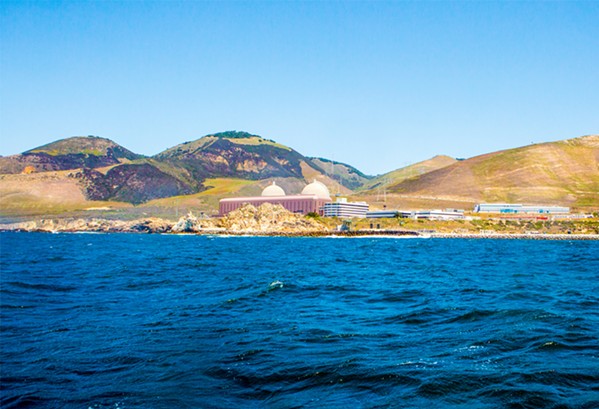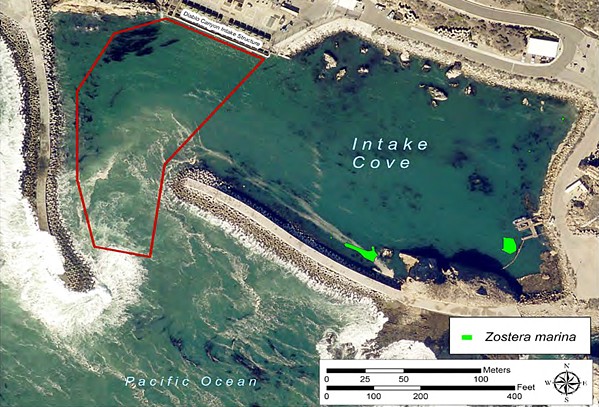Deep clean: PG&E needs to dredge Diablo Canyon's cove to unclog the intake system that helps the nuclear reactors stay cool
By Bulbul Rajagopal[{
"name": "Ad - Medium Rectangle CC01 - 300x250",
"id": "AdMediumRectangleCC01300x250",
"class": "inlineCenter",
"insertPoint": "8",
"component": "2963441",
"requiredCountToDisplay": "12"
},{
"name": "Ad - Medium Rectangle LC01 - 300x250",
"id": "AdMediumRectangleCC01300x250",
"class": "inlineCenter",
"insertPoint": "18",
"component": "2963441",
"requiredCountToDisplay": "22"
},{
"name": "Ad - Medium Rectangle LC09 - 300x250",
"id": "AdMediumRectangleLC09300x250",
"class": "inlineCenter",
"insertPoint": "28",
"component": "3252660",
"requiredCountToDisplay": "32"
}]
Pacific Gas and Electric Company (PG&E) is on standby to conduct the first deep clean of the Diablo Canyon Power Plant's seawater intake cove in nearly 40 years.
"We frequently survey the area and haven't needed to dredge in the past," PG&E spokesperson Suzanne Hosn told New Times. "Maintenance of the intake system is performed as required for personnel safety and plant reliability. The intent is to remove sediment to prevent circumstances that could impact the power plant's cooling system."
Diablo's seawater intake equipment cycles 2.5 billion gallons of water every day from the Pacific Ocean through pipes to absorb heat and cool depleted fuel pools and safety components. PG&E then discharges that warmed mass of water back into the ocean—reportedly disrupting the neighboring marine habitat, including that of the bull kelp.
In 2020, PG&E agreed to pay $5.9 million to the Bay Foundation of Morro Bay as part of a tentative settlement between the company and water regulators to resolve the 20-year investigation at the site into the effects of the warm water discharge in the cove.
Once scheduled for shutdown in 2025 because PG&E withdrew its applications to renew Diablo's twin reactor licenses set to expire in 2024 and 2025, the Avila Beach-based nuclear power plant received second wind.
PG&E applied for and received a $1.1 billon grant from the U.S. Department of Energy after state Senate Bill 846 passed in September 2022. The legislation unlocked $1.4 billion in state funding to help the company try to relicense Diablo and keep it running through 2030. The energy department grant aimed to backfill the state subsidies, and PG&E engaged with the Nuclear Regulatory Commission (NRC) to relicense Diablo's reactors. Though PG&E chose not to pursue renewal applications in 2018, it hoped the NRC would reinstate its original 2009 application with a timeliness exemption.
Last December, the California Public Utilities Commission approved a proposal to keep the reactors running, extending its life span through 2030.
But a rapid increase in sediment because of harsh winter storms and landslides on the Big Sur coast, along with burgeoning kelp and algal growth in the Diablo cove, creates the risk of an inadvertent shutdown. On March 14, the Coastal Commission planned to deliberate authorizing the dredging process—a mammoth task of excavating 70,000 cubic yards of shoaled sediment from the 10-acre cove and dumping it roughly 1,300 to 2,500 feet offshore at the Morro Bay sandspit.
"This is a relatively small, one-time activity," Hosn said. "We don't expect to have to dredge again during current or extended operations."
She added that PG&E originally intended to dredge last fall but delayed because of inclement weather. The company initially submitted the permit application to the Coastal Commission in July 2023 but brought forward a revised version in January. The postponement to this spring allowed the company's project managers to refine the process, bring down costs for customers, and finalize the necessary permit applications.
Removing that sediment will also help PG&E divers carry out their maintenance work. According to company notes shared with the Coastal Commission in January, divers manually clean accumulated kelp and algal debris off the intake system's bar racks every week. They do so using a combination of knives and nets.
Four to six times a year, two divers use a single fire hose to prevent sand encroachment into the vertical metal bar rack and gate system. The rack protects the opening of the 240-foot-long and 104-foot wide intake system and lets seawater be pumped into the power plant. Hosing off the bars isn't a substitution for dredging, the notes read.
"Water is constantly circulated since one unit is always in operations," the notes said. "Additionally, water is circulated to support heat removal of other systems (spent fuel pool) and desalination regardless of power generation status."
In the Coastal Commission's staff report about the dredging permit, staff said that it learned about a recent episode where divers hosed off sediment and debris in front of the intake structure in the cove without the necessary coastal development permit. The commission's enforcement division is now investigating the alleged violation. PG&E could resolve the issue by submitting an after-the-fact application for permit authorization, the report said.
"PG&E has committed to addressing the violation by applying for a permit that will fully address the situation," said Lisa Haage, the commission's chief of enforcement. "We expect they will comply and hope no further action will be required."
Commission staff recommended approving the permit for dredging. If the commission ultimately green-lights it, the permit will hinge on PG&E meeting 10 special conditions. These include dredging within a limited area to a depth of minus 36 feet; submitting a post-dredge survey and report within 60 days of completing the project; submitting for review a biological resources monitoring plan that caters to eelgrass protection; and submitting a marine wildlife protection plan for approval.
The commission is thinking of the fish too—specifically grunion. PG&E plan to dredge sediment in the spring if the permit is approved. But it'll have to keep grunion spawning season in mind, which runs from March through August. The company must rely on California Department of Fish and Wildlife reports for expected grunion runs and use tide predictions for Port San Luis to figure out the start of each two-hour run. PG&E cannot use the Morro Bay sandspit—at the U.S. Army Corps of Engineers' nearshore placement site—for sediment dumping two hours before, during, and after each grunion run.
"The project is not expected to adversely affect public access to the shoreline, as the dredging would occur in an area where public access is prohibited due to safety concerns and the sediment placement would occur more than 1,000 feet offshore of the nearest accessible shoreline area," the staff report said. Δ
Reach Staff Writer Bulbul Rajagopal at [email protected].
Latest in News
Comments (2)
Showing 1-2 of 2
Readers also liked…
-

Coast Unified teachers upset over new position's salary and qualifications
Oct 20, 2022 -

SLO police identify alleged driver who hit and killed couple
Dec 22, 2022 -

When the levee breaks: Oceano residents, county officials walk a tightrope of regulations to manage Arroyo Grande Creek, which some say led to the levee's failure in January
May 18, 2023











